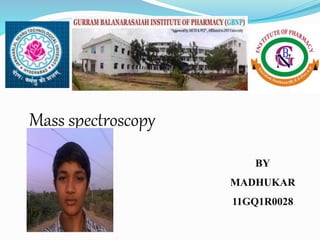
Mass Spectrometry Explained
- 1. BY MADHUKAR 11GQ1R0028 Mass spectroscopy
- 2. INTRODUCTION Mass or molecular weight of a compound can be found in several ways .one such technique is using mass spectrometer It is an analytical chemistry technique that helps identify the amount and type of chemicals present in a sample by measuring mass-to-charge ratio and abundance of gas-phase ions
- 3. Principle A mass spectrometer generates multiple ions from the sample under investigation This molecular ion undergoes fragmentation. Each primary product ion derived from the molecular ion, in turn, undergoes fragmentation, and so on.
- 4. The ions are separated in the mass spectrometer according to their mass-to-charge ratio, and are detected in proportion to their abundance. A mass spectrum of the molecule is thus produced. It displays the result in the form of a plot of ion abundance versus mass-to-charge ratio
- 6. Obtaining mass spectra consist of 2 types; Conversion of neutral molecule into a charged molecule, preferably to a positively charged molecule. Separation of the positively charged fragments formed, based on their masses, by using electrical or magnetic field or both.
- 7. Instrumentation The instrument consists of three major components: Ion Source: For producing gaseous ions from the substance being studied. Analyzer: For resolving the ions into their characteristics mass components according to their mass-to-charge ratio. Detector System: For detecting the ions and recording the relative abundance of each of the resolved ionic species.
- 8. Components of a Mass Spectrometer
- 9. In addition, a sample introduction system is necessary to admit the samples to be studied to the ion source while maintaining the high vacuum requirements (~10-6 to 10-8 mm of mercury) of the technique; and a computer is required to control the instrument, acquire and manipulate data, and compare spectra to reference libraries
- 11. With all the above components, a mass spectrometer should always perform the following processes; Separate these ions according to their mass-to-charge ratio in the mass analyzer. Eventually, fragment the selected ions and analyze the fragments in a second analyzer. Detect the ions emerging from the last analyzer and measure their abundance with the detector that converts the ions into electrical signals. Process the signals from the detector that are transmitted to the computer and control the instrument using feedback.
- 12. Chromatographic techniques combined with mass spectrometry An important enhancement to the mass resolving and mass determining capabilities of mass spectrometry is using it in tandem with chromatographic separation techniques.
- 13. Gas chromatography A common combination is gas chromatography-mass spectrometry (GC/MS or GC-MS). In this technique, a gas chromatograph is used to separate different compounds. This stream of separated compounds is fed online into the ion source, a metallic filament to which voltage is applied. This filament emits electrons which ionize the compounds. The ions can then further fragment, yielding predictable patterns. Intact ions and fragments pass into the mass spectrometer's analyzer and are eventually detected.
- 15. Liquid chromatography Indianapolis Museum of Art conservation scientist performing liquid chromatography– mass spectrometry.
- 16. Similar to gas chromatography MS (GC/MS), liquid chromatography-mass spectrometry (LC/MS or LC-MS) separates compounds chromatographically before they are introduced to the ion source and mass spectrometer. It differs from GC/MS in that the mobile phase is liquid, usually a mixture of water and organic solvents, instead of gas. Most commonly, an electro spray ionization source is used in LC/MS. Other popular and commercially available LC/MS ion sources are atmospheric pressure chemical ionization and atmospheric pressure photo ionization. There are also some newly developed ionization techniques like laser spray.
- 18. Applications Mass spectrometry has both qualitative and quantitative uses. Structure of elucidation; Using nitrogen rule, peak matching, fragmentation pattern of a compound and % abundance of isotopes, structure of elucidation of organic compounds can be done. Detection of impurities; Impurities present can be detected by the additional peaks, highest value of mass peaks then compound itself, & from the fragmentation pattern
- 19. MS is now in very common use in analytical laboratories that study physical, chemical, or biological properties of a great variety of compounds. As an analytical technique it possesses distinct advantages such as: Increased sensitivity over most other analytical techniques because the analyzer, as a mass-charge filter, reduces background interference Excellent specificity from characteristic fragmentation patterns to identify unknowns or confirm the presence of suspected compounds, Information about molecular weight.